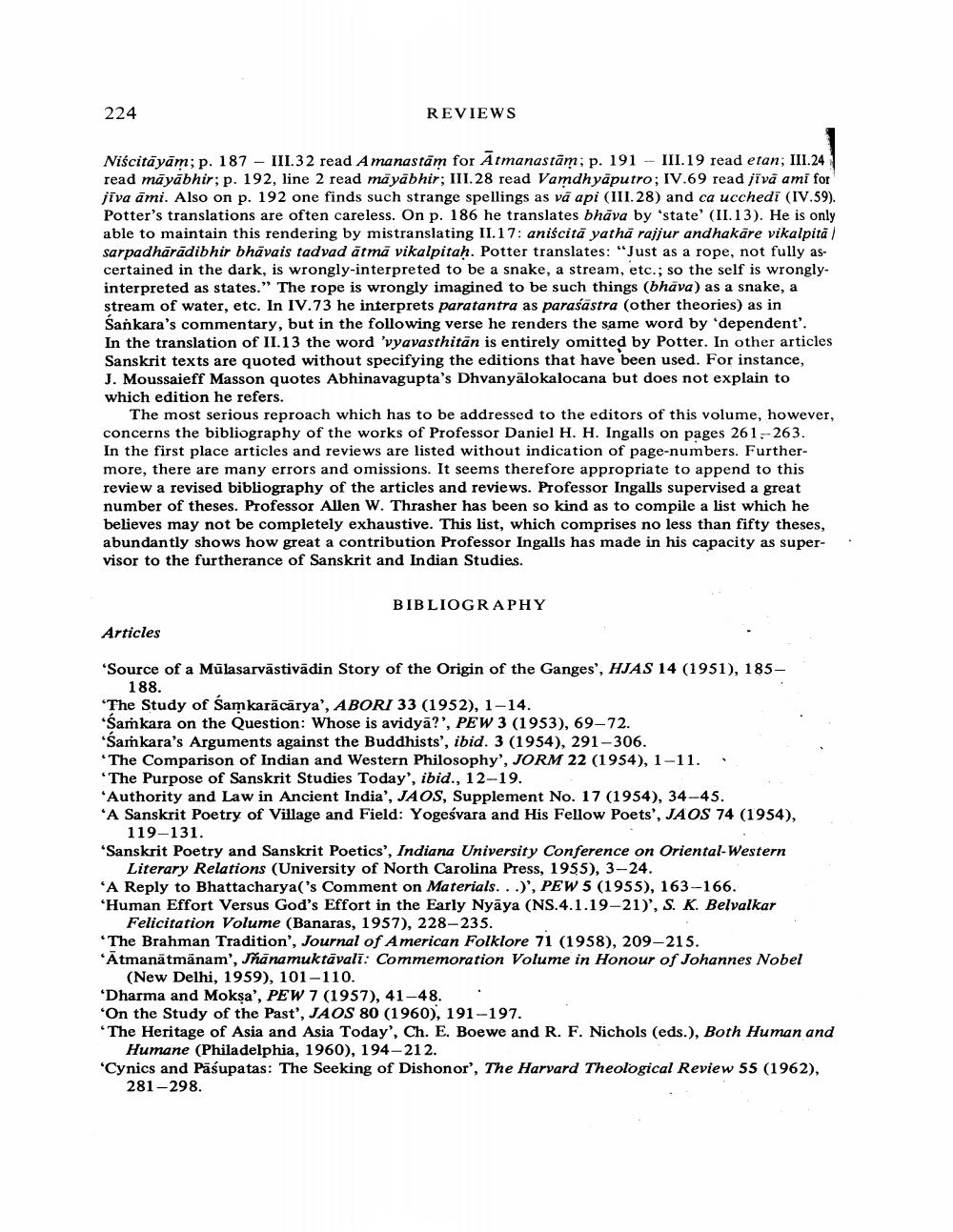________________
224
REVIEWS
Niścitāyām; p. 187 - III.32 read Amanastam for Atmanastām; p. 191 -- III.19 read etan; III.241 read māyābhir; p. 192, line 2 read māyābhir; III.28 read Vamdhyaputro; IV.69 read jīvā ami for jiva āmi. Also on p. 192 one finds such strange spellings as vā api (III.28) and ca ucchedi (IV.59). Potter's translations are often careless. On p. 186 he translates bhāva by 'state' (11.13). He is only able to maintain this rendering by mistranslating II.17: aniścitā yathā rajjur andhakāre vikalpita / sarpadhārādibhir bhāvais tadvad ätmă vikalpitaḥ. Potter translates: "Just as a rope, not fully ascertained in the dark, is wrongly-interpreted to be a snake, a stream, etc.; so the self is wrongly. interpreted as states." The rope is wrongly imagined to be such things (bhava) as a snake, a stream of water, etc. In IV.73 he interprets paratantra as parasāstra (other theories) as in Sankara's commentary, but in the following verse he renders the same word by dependent'. In the translation of II.13 the word 'vyavasthitan is entirely omitted by Potter. In other articles Sanskrit texts are quoted without specifying the editions that have been used. For instance, J. Moussaieff Masson quotes Abhinavagupta's Dhvanyalokalocana but does not explain to which edition he refers.
The most serious reproach which has to be addressed to the editors of this volume, however, concerns the bibliography of the works of Professor Daniel H. H. Ingalls on pages 261-263. In the first place articles and reviews are listed without indication of page-numbers. Furthermore, there are many errors and omissions. It seems therefore appropriate to append to this review a revised bibliography of the articles and reviews. Professor Ingalls supervised a great number of theses. Professor Allen W. Thrasher has been so kind as to compile a list which he believes may not be completely exhaustive. This list, which comprises no less than fifty theses, abundantly shows how great a contribution Professor Ingalls has made in his capacity as supervisor to the furtherance of Sanskrit and Indian Studies.
BIBLIOGRAPHY
Articles
'Source of a Mulasarvāstivādin Story of the Origin of the Ganges', HJAS 14 (1951), 185
188. "The Study of Samkarācārya', ABORI 33 (1952), 1-14. "Sarkara on the Question: Whose is avidyä?', PEW 3 (1953). 69-72. 'Samkara's Arguments against the Buddhists', ibid. 3 (1954), 291-306. 'The Comparison of Indian and Western Philosophy', JORM 22 (1954), 1-11.
The Purpose of Sanskrit Studies Today', ibid., 12-19. 'Authority and Law in Ancient India', JAOS, Supplement No. 17 (1954), 34-45. 'A Sanskrit Poetry of Village and Field: Yogeśvara and His Fellow Poets', JAOS 74 (1954),
119-131. Sanskrit Poetry and Sanskrit Poetics', Indiana University Conference on Oriental-Western
Literary Relations (University of North Carolina Press, 1955), 3-24. 'A Reply to Bhattacharya('s Comment on Materials...), PEW 5 (1955), 163-166. 'Human Effort Versus God's Effort in the Early Nyāya (NS.4.1.19-21)', S. K. Belvalkar
Felicitation Volume (Banaras, 1957), 228-235. *The Brahman Tradition', Journal of American Folklore 71 (1958), 209-215. Ātmanātmānam', Jhānamuktāvali: Commemoration Volume in Honour of Johannes Nobel
(New Delhi, 1959), 101-110. 'Dharma and Moksa', PEW 7 (1957), 41-48. 'On the Study of the Past', JAOS 80 (1960), 191-197. “The Heritage of Asia and Asia Today', Ch. E. Boewe and R. F. Nichols (eds.), Both Human and
Humane (Philadelphia, 1960), 194-212. "Cynics and Pasupatas: The Seeking of Dishonor', The Harvard Theological Review 55 (1962),
281-298.




